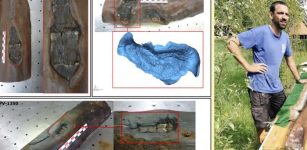Khopesh Sword – Symbolic Weapon Of The Pharaohs And Emblem OF Egyptian Deities
Angela Sutherland - AncientPages.com - Among many ancient weapons, we find their most unusual shapes.
One such weapon is the bronze khopesh, a sickle-shaped sword, usually described as a kind of sword-ax, widely used among warriors in the ancient Near East from 3000 BC to about 1300 BC.
Harpe-AO 4354 - khopesh / archaeological artifact - circa 2000 BC. Image credit: Rama- CC BY-SA 3.0 FR
The khopesh weapon was prevalent among Babylonians, Phoenicians, Egyptians, and many other ancient cultures. There is "a remarkable similarity of a type of sword from Benin in West Africa" and the khopesh sword. 1
The khopesh is mainly known from Egypt and, for the first time, is in the sources of the XVII dynasty as the weapon of Pharaoh Kamose, the last king of the 17th dynasty (c. 1630–1540 BC). In manufacturing this weapon, the Egyptians learned from the Canaanites or took it directly from the invading Hyksos, along with other military innovations.
In many depictions, the khopesh represents an emblem of the Egyptian deities and a symbolic weapon of the Pharaohs. Some khopesh were discovered in royal graves, such as the two examples found with Tutankhamun.
In her book "Warfare and Weaponry of Dynastic Egypt," Rebecca Dean writes that "while the ax remained an important weapon throughout the Eighteenth Dynasty, it at times appeared to be gradually replaced with the sickle sword - the khopesh."
 Relief of Ramses III at Medinet Habu, Theban Necropolis, Egypt. The Pharaoh is using the Khopesh Sword. Credit: I, Rémih - CC BY-SA 3.0
Relief of Ramses III at Medinet Habu, Theban Necropolis, Egypt. The Pharaoh is using the Khopesh Sword. Credit: I, Rémih - CC BY-SA 3.0
The author describes the weapon's blade as "wedge-shaped (widening at the back) with the cutting edge on the outer edge, as in the case of the scimitar blade, and functioned as a long and thin, almost ax-like weapon. Typically, the weapon is 50-60 cm (20–24 inches) long, but also smaller specimens are found. Its sharpness concentrates only on the outside portion of the curved end." 2
Technically, the khopesh is distinguished from other weapons by its considerable penetration. Its weight was approximately two kilograms, and the unique shape allowed the warrior to choose the way to attack in different conditions.
Khopesh Evolved From Epsilon Axes
The khopesh evolved from the epsilon or similar crescent-shaped axes used in warfare.
Dan Howard writes in his book "Bronze Age Military Equipment" that "the khopesh shows" the probable evolution from the epsilon ax (not the sickle). The epsilon ax was likely the ancestor of the khopesh. Cutting typologies were more common in Egypt, but they also used piercing axes." 3
The khopesh's blade's blunt end edge effectively served as a stick and hook. The inside curve was used to trap an opponent's arm or pull his shield out of the way.
The handle is separated from the barrel by a slight thickening, which forms a barrier directly protecting the hand from a blow. A straight handle with an extended or bent head helps to strengthen the grip.
 Bronze Khopesh sword from the time of Ramses II. Credit: Aoineko - CC BY-SA 3.0
Bronze Khopesh sword from the time of Ramses II. Credit: Aoineko - CC BY-SA 3.0
These weapons changed from bronze to iron in the New Kingdom period between the 16th century BC and the 11th century BC, covering Egypt's Eighteenth, Nineteenth, and Twentieth dynasties.
In ancient Egypt, the word khopesh (perhaps derived from "leg" ("leg of beef") because of their similarity in shape. The hieroglyph for ḫpš ('leg' or (kh.p.sh = 'knee') is found as early as the Coffin Texts (c. 2181–2055 BC).
Weapon Smiths Worked Hard To Devise This Sophisticated Not Commonly Used Elite Weapon
Many weapon smiths worked hard for a very long time to produce a long sword that was both resilient and capable of taking a hard edge so that it could be used effectively for striking and thrusting. One solution was the bronze khopesh that "despite its odd shape, was widely used in the Middle East, and subsequently evolved into such swords as the Greek "machaira" and the Ghurka "kukri," traditionally associated with the Nepali-speaking Gurkhas of Nepal and India. 2
The earliest known depiction of a khopesh is from the Stele of Vultures, showing King Eannatum of Lagash with the khopesh in his hand; this would date the khopesh to at least 2500 BC. There are other depictions of the khopesh, too.
 Bronze Egyptian Khopesh with the name of Pharaoh Ramses II. Louvre Museum.
Bronze Egyptian Khopesh with the name of Pharaoh Ramses II. Louvre Museum.
One of the earliest is on a Mari cylinder seal. At Byblos and Shechem, a Canaanite city mentioned in the Amarna letters and the Hebrew Bible's first capital of the Kingdom of Israel dated to a century later.
Except for battles, the khopesh also represented one of the emblems associated with the most important deities of ancient Egypt and symbolized the magical weapon of the Pharaoh.
In art, this sword of Egyptian warriors - was a sign of victory over enemies.
In addition, in this role, the weapon also appears in Egyptian mythology and astronomy. As stated in the hieroglyphs, the ancient Egyptian star deity Mesechtiu originated from the constellation Khopesh (Big Dipper). The Egyptian god Mesechtiu is later mentioned in the Book of the Dead.
The khopesh came out of use about 1300 BC; however, nomadic tribes called Shasu (Bedouins) used it during the 19th dynasty.
Written by – A. Sutherland - AncientPages.com Senior Staff Writer
Updated on January 22, 2023
Copyright © AncientPages.com All rights reserved. This material may not be published, broadcast, rewritten or redistributed in whole or part without the express written permission of AncientPages.com
Expand for references- Bondarenko, Dmitri M., and Peter M. Roese. "Benin Prehistory: The Origin and Settling down of the Edo." Anthropos94, no. 4/6 (1999): 542-52
- Rebecca Dean, "Warfare and Weaponry of the Dynastic Egypt",
- Dan Howard, "Bronze Age Military Equipment"
BLAIR, CLAUDE. "METALS IN THE SERVICE OF MARS: ARMS AND ARMOUR." Journal of the Royal Society of Arts 129, no. 5304 (1981): 764-81.
More From Ancient Pages
-
 What Were Ancient Egyptian Schools Like?
Ancient History Facts | Jul 14, 2016
What Were Ancient Egyptian Schools Like?
Ancient History Facts | Jul 14, 2016 -
 On This Day In History: Mathematician And Astronomer Simon Marius Independently Rediscovered Andromeda Galaxy – On Dec 15, 1612
News | Dec 15, 2016
On This Day In History: Mathematician And Astronomer Simon Marius Independently Rediscovered Andromeda Galaxy – On Dec 15, 1612
News | Dec 15, 2016 -
 Forgotten And Overgrown Step Pyramid Of Koh Ker – Ancient Memory Of The Khmer Empire
Featured Stories | Apr 19, 2017
Forgotten And Overgrown Step Pyramid Of Koh Ker – Ancient Memory Of The Khmer Empire
Featured Stories | Apr 19, 2017 -
 Clues What Tiggered Climate Change 8,000 Years Ago Found In Scotland
News | Sep 15, 2023
Clues What Tiggered Climate Change 8,000 Years Ago Found In Scotland
News | Sep 15, 2023 -
 On This Day In History: Adolph Bandelier Swiss-American Who Studied The American Indian Cultures – Born – August 6, 1840
News | Aug 6, 2016
On This Day In History: Adolph Bandelier Swiss-American Who Studied The American Indian Cultures – Born – August 6, 1840
News | Aug 6, 2016 -
 Bizarre And Unexplained Phenomenon That Defied The Laws Of Nature
Featured Stories | May 12, 2018
Bizarre And Unexplained Phenomenon That Defied The Laws Of Nature
Featured Stories | May 12, 2018 -
 ‘Holystone’ – Stone Chest With Jesus Christ’s Cross Found At Balatlar Church In Turkey’s Sinop
Archaeology | Mar 4, 2020
‘Holystone’ – Stone Chest With Jesus Christ’s Cross Found At Balatlar Church In Turkey’s Sinop
Archaeology | Mar 4, 2020 -
 Cats In The Middle Ages: What Medieval Manuscripts Teach Us About Our Ancestors’ Pets
Featured Stories | Dec 24, 2022
Cats In The Middle Ages: What Medieval Manuscripts Teach Us About Our Ancestors’ Pets
Featured Stories | Dec 24, 2022 -
 3,200-Year-Old Mycenaean Statuette Sheds New Light On The Hittites
Archaeology | Jun 22, 2022
3,200-Year-Old Mycenaean Statuette Sheds New Light On The Hittites
Archaeology | Jun 22, 2022 -
 Cheomseongdae “Star-Gazing Tower” Is The Oldest Observatory In East Asia
Featured Stories | Mar 31, 2021
Cheomseongdae “Star-Gazing Tower” Is The Oldest Observatory In East Asia
Featured Stories | Mar 31, 2021 -
 4,500-Year-Old Row Of Giant Monoliths Found – Could Be the Largest In Britain
News | Sep 7, 2015
4,500-Year-Old Row Of Giant Monoliths Found – Could Be the Largest In Britain
News | Sep 7, 2015 -
 World’s Oldest Tattoos Discovered On Egyptian Mummies Re-Write History Of Tattoos
Archaeology | Mar 2, 2018
World’s Oldest Tattoos Discovered On Egyptian Mummies Re-Write History Of Tattoos
Archaeology | Mar 2, 2018 -
 Underwater Drone Images Reveal Oldest Human-Made Structure In The Baltic Sea
Archaeology | Feb 13, 2024
Underwater Drone Images Reveal Oldest Human-Made Structure In The Baltic Sea
Archaeology | Feb 13, 2024 -
 3,000-Year-Old Bakery With Large Amounts Of Flour Discovered In Armenia
Archaeology | Jul 3, 2023
3,000-Year-Old Bakery With Large Amounts Of Flour Discovered In Armenia
Archaeology | Jul 3, 2023 -
 Strange And Scary Encounter With Ancient Giants In North America
Ancient Mysteries | Sep 23, 2021
Strange And Scary Encounter With Ancient Giants In North America
Ancient Mysteries | Sep 23, 2021 -
 Biblical Cherubim – Sweet Angels Or Dangerous Creatures With A Hidden Agenda?
Ancient Mysteries | Jun 9, 2018
Biblical Cherubim – Sweet Angels Or Dangerous Creatures With A Hidden Agenda?
Ancient Mysteries | Jun 9, 2018 -
 Earliest Evidence Of Forest Management Discovered At The La Draga Neolithic Site
Archaeology | Jul 18, 2023
Earliest Evidence Of Forest Management Discovered At The La Draga Neolithic Site
Archaeology | Jul 18, 2023 -
 Is The World’s Oldest Zero Hidden In The Bakhshali Manuscript?
Archaeology | Oct 28, 2017
Is The World’s Oldest Zero Hidden In The Bakhshali Manuscript?
Archaeology | Oct 28, 2017 -
 Waru Waru – Ancient Andean Irrigation System Brought Back To Life
Ancient History Facts | Apr 28, 2018
Waru Waru – Ancient Andean Irrigation System Brought Back To Life
Ancient History Facts | Apr 28, 2018 -
 Scotland’s First Farmers Didn’t Need Manure To Fertilize Their Fields – The Land Was Still Very Productive
Archaeology | Oct 12, 2022
Scotland’s First Farmers Didn’t Need Manure To Fertilize Their Fields – The Land Was Still Very Productive
Archaeology | Oct 12, 2022

